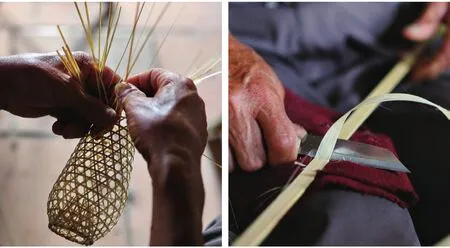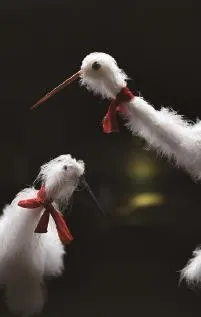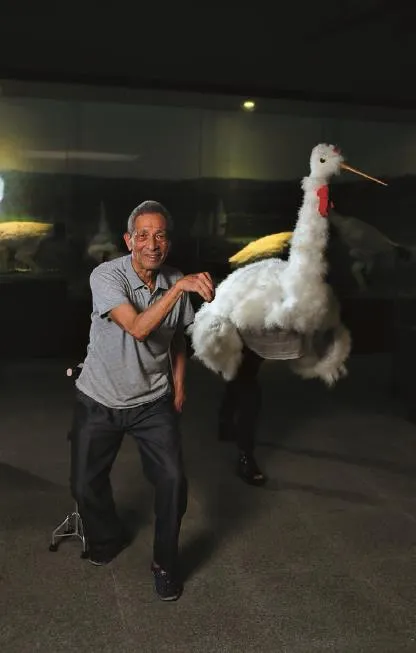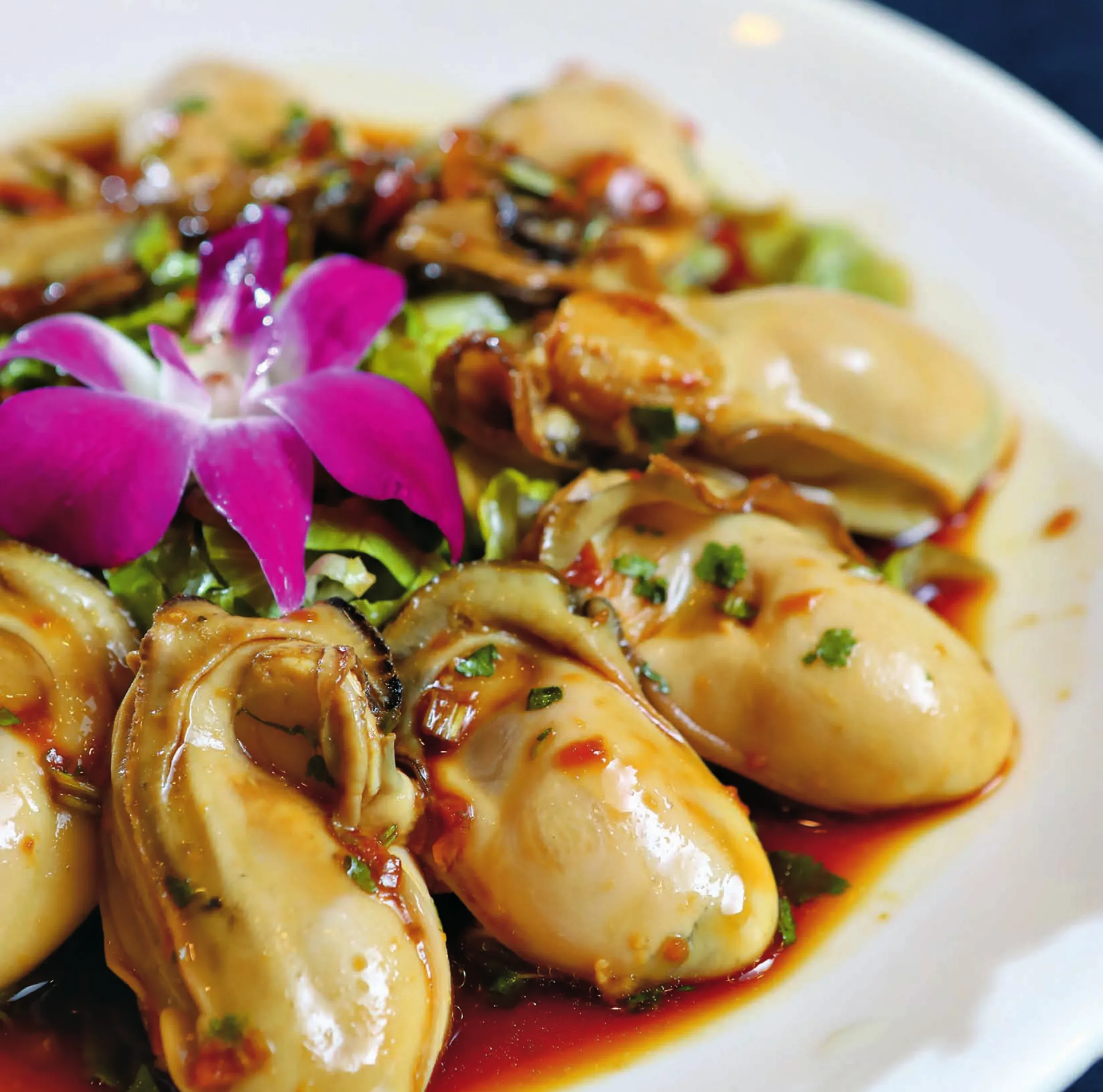Small City Of Great Wisdom
Text by Madeline Weng Photos by Zeng Jian & VCG Translation by Sonia Illustration by Nan Fang
Small City Of Great Wisdom
Text by Madeline Weng Photos by Zeng Jian & VCG Translation by Sonia Illustration by Nan Fang
The charisma of a city is often found among the backstreet alleyways. From the fi shermen working diligently on the beach, vigorous senior performers in crane costumes, and the therapeutic massage master treating patients with endogenous power, it is apparent that the people's wisdom and pragmatism is exactly the reserved wealth the city Zhuhai has cultivated for a millennium.

Qianwu Town, Doumen District, is located in the coastal sand land at the west of Zhuhai City. It boarders the South Sea and the climate is warm. In addition, there is a dense water network and the salinity of sea water is perfect, providing water composition and a natural food source for growing sea catfish.斗門區乾務鎮地處珠海市西部的濱海大沙田地區,瀕臨南海,氣候溫潤;加之水網交錯,海水咸淡適宜,為泥魚的生長提供了水質和天然的食物來源。
小城大智
一座城市的味道,往往存在于尋常巷陌中。從灘涂上辛勤勞作的捉魚人,披著鶴衣神采奕奕的老藝人,以內力醫病的推拿大師身上,不難捕捉到來自民間的智慧與低調的務實精神,這正是珠海這座城市孕育千年的無聲財富。

Making baskets: Cut and grind the bamboo. Bend the bamboo and cut in to slices of ten with a knife. Weave the slices to one bottomless, vase-shaped basket.編泥魚籠的主要過程:削竹子,將其打磨光滑,隨后施力弄彎,用利刀平均切割成十幾條細長的竹條,編織成一只無底花瓶形狀的簍子。
Fisheries in Fertile Land
Sixty-three-year-old Hushan fi sherman Huang Guofu witnessed the highs and lows of the custom of trapping sea catfi sh in Qianwu Town.
“In the mid-20th century, when trapping sea catfi sh reached its peak, the routine in every household was to catch fi sh very early in the morning and make baskets after returning home in the evening,”said Huang. “The baskets made of bamboo are thin and need to be replaced frequently. We didn't have electric light at the time, so we lit up oil lamp at night and the whole family made the baskets together. At three in the morning, we had to set out to catch fi sh and didn't return home until eight in the evening.”
Huang started learning how to make baskets from the older generation at the age of 14. As a beginner, he got cuts on his hands by the bamboo burrs, but he gradually mastered the craft. Now it takes only eight minutes for Huang to make a basket, three times faster than other villagers.
This vase-shaped fi sh-catching device is the fruit of Qianwu fi shermen's folk wisdom accumulated over three hundred years. The end with its larger opening has a one-way passage – once the sea catfi sh get in, there is no way out.
“Sea catfi sh are keen and will dig into the mud upon any noise. We will not be able to catch them with our bare hands. So we place baskets in area with signs of fi sh movement. As soon as we go away, the fi sh will come out boldly and swim into the baskets for us to harvest!” Huang Guofu spoke with a sly smile on his tanned face. Huang brings 200 baskets every time he goes trapping sea catfi sh, putting 100 baskets at each end of the beach and later collecting the baskets in sequential order.
Sea catfi sh grow to the largest between November and February D the best time for trapping sea catfi sh. The fi shermen invented a step-on plate to prevent their knees from sinking into the cold beach in winter. The plate creates a wider service area so the fi shermen are less likely to sink.
Nowadays, the beaches in Hushan Village have been turned to cropland and farms growing fi sh and shrimps. Only a small part of the beach is kept for trapping sea catfi sh. In 2010, this folk custom was selected to be on the list of the Intangible Cultural Heritage in China. It was remedially protected. Huang is invited to teach pupils to weave baskets every week, but he's not sure how long this tradition will last.
沃土漁情

Huang GuofuInheritor of Trapping Sea Catfish, National Intangible Cultural Heritage黃國富國家級非物質文化遺產“裝泥魚”傳承人
63歲的虎山漁民黃國富見證了乾務鎮“裝泥魚”習俗的高低潮。
上世紀中葉,“裝泥魚”最盛的時候,家家戶戶都得早起捕魚,晚歸編籠。黃國富說:“竹籠薄,需要經常更換。那時候沒有電燈,我們晚上就點著煤油燈,全家一起編籠子。早上3點,我們又得出發捕魚,忙到8點才能回家。”
黃國富14歲便開始和老一輩學編籠。初學時,他也會被竹刺劃破手,漸漸地便熟練了。現在,黃國富編織一個泥魚簍只需要8分鐘左右的時間,比一般村民快三倍。
這只花瓶形狀的“捕魚神器”凝聚了乾務漁民三百多年來的民間智慧——籠子開口較大的一端設有一個單向通道,泥魚一旦游入其中,便無從逃出。
“泥魚很靈敏,一聽到動靜就會鉆進泥里,用手抓不到。我們就在有魚蹤跡的地方放上魚籠,等我們走開了,泥魚就大膽地出來,游到籠子里等我們收!”說著,黃國富黝黑的臉上浮現出一抹狡黠的笑容。每次去“裝泥魚”,黃國富都會帶上200只泥魚籠,在灘涂區域的兩邊各安置好100只籠子,然后緊接著回過頭按順序收籠。
泥魚最肥的季節通常是11月到2月,那時也是“裝泥魚”最好的時機。為了避免雙膝陷入冬天冰冷的灘涂中,漁民們還發明了踩踏用的泥板,降低了站在灘涂上時的壓強,不容易沉下去。
如今,虎山村里的灘涂已經被開發為田地和魚蝦養殖場,留給“裝泥魚”的灘涂只有小小一塊。2010年,這項民間習俗被列入了國家非物質文化遺產名錄,被予以搶救性的保護和傳承。現在,黃國富受邀每周去小學教孩子們編魚籠。“裝泥魚”究竟還能走多遠,還是個未知數。
Crane Dance Sending Blessings


The custom of crane dance originated from an intriguing legend in Sanzao Town, Jinwan District. One day, a lion got into a fi ght with a crane. A whitehaired old man came to mediate, persuading them to bid New Year blessings to every house since it was the New Year time and people will give red envelopes in return. Therefore, the crane and the lion started to wish people Happy New Year together at people's doorstep.
Sanzao is the largest island among Wanshan Islands. The island is surrounded by a large area of mangroves, beaches, and wetland. Abundant food source and proper living conditions attract animals like cranes to dwell here. To the Sanzao people, cranes represent virtue and longevity and the crane dance is a beautiful blessing.
This folk dance has lasted for 700 years to date. Whenever it is the holiday, the lion and crane dance teams in Haicheng Village, Sanzao Town, go to every household to perform. Dozens of people walk in parade, beating gongs and drums along the way. A lion pays respect at the door, and the crane and another lion enter the house, bowing at each other and greeting the senior people.
A crane dancer has to wear a white crane costume that weighs 4 kg, lifting crane head with hands and making all sorts of moves to demonstrate crane elegance. Different from the lion dance,
the crane dance not only mimes a crane's acts of catching fi sh, fl ying and frolicking but also goes with melodious crane songs, accompanied by drums, gongs and cymbals. The sound is deep and festive. Moreover, the lyrics of crane songs are sophisticated, often working as entertainment and education. Therefore, the locals are used to having children follow the lessons taught by the crane songs.
As society changes, this folk art relying on oral transmission is on the edge of extinction. To save the crane dance, after retirement Chen Fuyan started documenting the crane dance; he recorded methods of making crane costumes and performance steps through photos and marginal notes. Starting in 2008, elementary schools in the village began to set up crane dance legacy classes, training students selected by Chen free of charge. Until this day Chen has nurtured more than a thousand young successors.


Moves of Crane Dance.鶴舞分解動作示意圖。
鶴舞送福
三灶舞白鶴的習俗,緣起于金灣區三灶鎮一個有趣的傳說:有一天,一只獅子和鶴打起來了,一位白發老人前來勸架,說現在大過年的,它倆要是一起拜年,每家每戶都會給紅包。于是,仙鶴和獅子便來到了人家門前拜年。
三灶是萬山群島中的第一大島,海島周圍有大面積的紅樹林、灘涂和濕地,豐富的食物和適宜的環境常吸引白鶴等飛禽走獸到此棲息。在三灶人心中,白鶴象征著高潔與長壽,鶴舞則是為人送去美好的祝福。
至今,這種民俗舞蹈已經延續700年了。每到逢年過節,三灶鎮海澄村里的醒獅和舞鶴隊便會到家家戶戶門前,幾十個人敲鑼打鼓而行,一只獅子負責拜家門,而鶴則與另外一只獅子一同進屋,互相作揖、賀老拜壽。
舞鶴人需身披8斤重的潔白鶴衣,手舉鶴頭,做出種種靈活的動作,展現仙鶴傲人身姿。與舞獅不同的是,鶴舞除了模仿白鶴捕魚、飛翔、嬉戲等動作以外,還配以曲調悠揚的“鶴歌”,用鼓、鑼、鈸敲打伴奏,聲音洪厚,年味十足。此外,鶴歌歌詞高雅,通常有寓教于樂的作用;因此,當地人還有讓孩子聽從鶴歌教導的習慣。
隨著社會變遷,這項依賴口口相傳的民間藝術瀕臨失傳。為了挽救鶴舞,退休后的陳福炎開始對鶴舞的總結和記錄,通過配圖和注釋完整記載了鶴衣的制作方法及表演程序等。2008年起,村里的小學紛紛開設了鶴舞傳承班,由陳福炎為挑選出的苗子進行免費培訓。至今,陳福炎已經培養了上千名“小傳人”。

Chen FuyanInheritor of Sanzao Crane Dance, National Intangible CulturalHeritage陳福炎國家級非物質文化遺產“三灶鶴舞”傳承人

One-finger Zen message techniques: roll, rub, push, shake, stretch, pinch, etc.一指禪推拿手法:滾、揉、推、抖、拉、捻等。
Practice Medicine with Inner Power
One-fi nger Zen originates from Buddhism, passing down to the martial arts and Chinese medicine.
Han Jingshen with his martial arts background has practiced medicine in Zhuhai for two decades. Through therapeutic practices and internal refl ection, he inherited the One-Finger Zen Massage that had been passed down for 150 years. This therapeutic method takes the goal of “fi nding one's true self” in Zen Buddhism and takes Chinese medical theories as its foundation; it is often applied to solve muscle, spine and bone issues, such as knee degeneration and cervical vertebra injuries.
Han believes that kung fu is the basis of Chinese medicine. Learners have to capture the concept of life and anatomy through practices kung fu so as to exert their ability better in treating patients. Usual masseurs' strength is restricted to the hands but One-Finger Zen comes from the whole body. When the therapists transmit their strength, their bodies move naturally like swimming jellyfi sh. Any slight change will affect everything. This massage method supported by kung fu can relieve patients' pain at the time of massage. Han concluded a set of procedure on the basis of Yiquan and Chinese medicine exclusively for the learning of One-Finger Zen Massage. He promotes that learners will understand the movement of “chi”by cultivating their minds, spirits, and treatment skills, understand the diseases, and therapeutic principles through practicing.
Han Jingshen has personally trained almost 100 students. Besides specifi c technology and skill, One-Finger Zen Massage learners should practice Zen and learn how to diagnose with heart, sensing a patient's pain as if it is their own. A good message therapist can't merely pursue skills. They have to thoroughly understand the living body in order to discover the internal cause hidden in a patient's body, recognize big problems from small signs, and conduct treatments based on differentiation.


以道行醫
“一指禪”來源于佛家智慧,一脈傳入武術,一脈融入中醫。
出身武門的韓競生在珠海行醫已三十余載。通過醫療實踐和內觀感悟,他繼承了歷經150年口傳心授的“一指禪推拿療法”。這套療法以禪宗“明心見性”學說為宗旨,以中醫理論為基礎,常被用于解決筋骨問題,如膝關節退化、腰椎、頸椎病等。
韓競生認為,練功是中醫的基本功夫;推拿醫生須練好推拿功法和療法,在治療時才能更好地發力。一般按摩師傅的發力點多局限于手部,而一指禪的發力點則在于全身,施力時,醫者的形體仿如水母游泳般自然,牽一發而動全身。這種以功夫為支撐的推拿手法能夠真正做到“手隨心轉,法從手出”。為此,韓競生在“意拳”和中醫導引學的基礎上總結了一套功法,專門用于一指禪推拿的學習。他倡導習者通過“修心、修命、修技、修治”了解到“精、氣、神”的運動,認識疾病,從而了解治療的原則。
至今,韓競生已親手帶出近百名徒弟。他認為,“一指禪推拿”的學習者必須修煉禪心,學會用心看病,由己及人地體察到病人的痛苦。一個好的推拿醫生不能僅僅追求手法,只有對人體的活體生命有充分的感受和了解,在臨癥時才能做到“由表及里”,“見微知著”,“辨證論治”,在治療操作時才能真正達到“法之所施,病人不知其苦”。

Han JingshenThe fifth-generation representative inheritor of One-Finger Zen Massage韓競生一指禪推拿流派第五代代表性傳承人

Jade and Pearl Oysters is an award-winning dish.獲獎菜式“翡翠珍珠蠔”。

